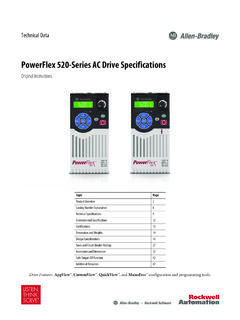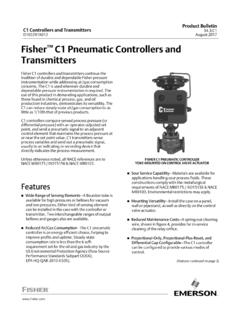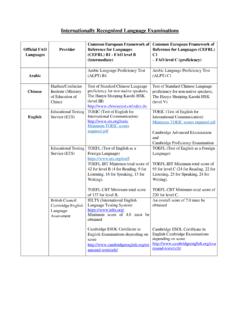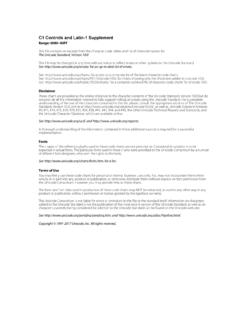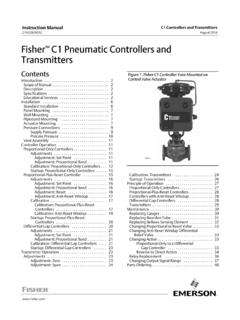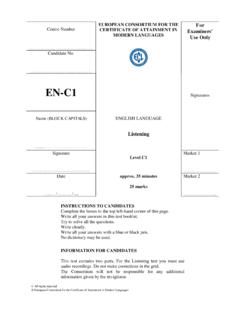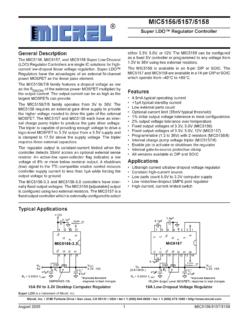Transcription of MT-070: In-Amp Input RFI Protection
1 MT-070. TUTORIAL. In-Amp Input RFI Protection PROTECTING IN-AMPS AGAINST RFI. Real-world applications must deal with an ever increasing amount of radio frequency interference (RFI). Of particular concern are situations in which signal transmission lines are long and signal strength is low. This is the classic application for an In-Amp , since its inherent common-mode rejection allows the device to extract weak differential signals riding on strong common-mode noise and interference. One potential problem that is frequently overlooked, however, is that of radio frequency rectification inside the In-Amp .
2 When strong RF interference is present, it may become rectified by the internal junctions of the IC and then appear as a dc output offset error. Common-mode signals present at an In-Amp 's Input are normally greatly reduced by the amplifier's common-mode rejection. Unfortunately, RF rectification occurs because even the best in-amps have virtually no common-mode rejection at frequencies above 20 kHz. A strong RF signal may become rectified by the amplifier's Input stage and then appear as a dc offset error. Once rectified, no amount of low-pass filtering at the In-Amp output will remove the error.
3 If the RF interference is of an intermittent nature, this can lead to measurement errors that go undetected. COMMON-MODE (CM) AND DIFFERENTIAL-MODE (DM) RC Input FILTERS. A general-purpose approach to proper filtering for device level application of in-amps is shown in Figure 1. In this circuit the In-Amp could be any one of a number of devices. The relatively complex balanced RC filter preceding the In-Amp performs all of the high frequency filtering. The In-Amp would be programmed for the gain required in the application, via its gain-set resistance (not shown). Within the filter, note that fully balanced filtering is provided for both CM (R1-C1 and R2-C2).
4 As well as differential mode (DM) signals (R1+R2, and C3 || the series connection of C1-C2). If R1-R2 and C1-C2 aren't well matched, some of the Input common-mode signal at VIN will be converted to a differential mode signal at the In-Amp inputs. For this reason, C1 and C2 should be matched to within at least 5% of each other. Also, R1 and R2 should be 1% metal film resistors, so as to aid this matching. It is assumed that the source resistances seen at the VIN terminals are low with respect to R1-R2, and matched. In this type of filter, C3 should be chosen at least ten times larger than C1 or C2.
5 (C3 10C1, 10C2), in order to suppress spurious differential signals due to CM-to-DM. conversion resulting from mismatch of the R1-C1 and R2-C2 time constants. , 10/08, WK Page 1 of 6. MT-070. R1. +. C1 VOUT. VIN C3 In-Amp . R2 C2. _. DIFF = (R1 + R2) C1. C1 C2. + C2 + C3. CM = R1 C1 = R2 C2. DIFF > 10 CM. R1 C1 = R2 C2. R1 = R2 SHOULD BE 1% RESISTORS. C1 = C2 SHOULD BE 5% CAPACITORS. 1. DIFFERENTIAL =. FILTER BANDWIDTH 2 (R1 + R2) C1 C2. C1 + C2 + C3. Figure 1: A General-Purpose Common-Mode/Differential-Mode RC. EMI/RFI Filter for In-Amps The resulting CM filter bandwidth is 1/2 R1 C1, and the DM filter bandwidth is approximately 1/4 R1 C3, assuming that C3 >> C1.
6 The overall DM filter bandwidth should be at least 100 times the Input signal bandwidth. Physically, the filter components should be symmetrically mounted on a PC board with a large area ground plane and placed close to the In-Amp inputs for optimum performance. Figure 2 shows a family of these filters, as suited to a range of different in-amps. The RC. components should be tailored to the different In-Amp devices, as per the table. These filter components are selected for a reasonable balance of low EMI/RFI sensitivity and a low increase in noise (vis- -vis that of the related In-Amp , without the filter).
7 To test the EMI/RFI sensitivity of the configuration, a 1 V p-p CM signal can be applied to the Input resistors, as noted. With a typically used In-Amp such as the AD620 working at a gain of 1000, the maximum RTI Input offset voltage shift observed was V over the 20 MHz range. In the AD620 filter example, the differential bandwidth is about 400 Hz. Page 2 of 6. MT-070. 50 . SINEWAVE. RF CM test SOURCE. DC - 20 MHz 1V p-p RG. R1. +. C1 VOUT. VIN C3 U1. C2. R2. _. U1 R1/R2 C1/C2 C3. 1% 5% 10%. AD620/621/622 1nF 47nF. AD623 10k 1nF 22nF. AD627 20k 1nF 22nF. Figure 2: Flexible Common-Mode and Differential-Mode RC EMI/RFI Filters are useful with the AD620 Series, the AD623, AD627, and other In-Amps 50 RF CM test SINEWAVE DC - 20 MHz SOURCE 1V p-p RG.
8 +. AD620 VOUT. VIN AD621. AD622. _. COMMON MODE CHOKE: PULSE ENGINEERING B4001. Figure 3: For Simplicity as well as Lowest Noise EMI/RFI Filter Operation, a Common-Mode Choke is useful with the AD620 Series In-Amp Devices Page 3 of 6. MT-070. In addition to being a low component count approach, choke-based filters offer low noise, by dispensing with the resistances. Selecting the proper common-mode choke is critical, however. The choke used in the circuit of Figure 3 above is a Pulse Engineering B4001. The maximum RTI offset shift measured from dc to 20 MHz at G = 1000 was V. Either an off-the-shelf choke such as the B4001 can be used for this filter, or, alternately one can be constructed.
9 Since balance of the windings is important, bifilar wire is suggested. The core material must of course operate over the expected frequency band. Note that, unlike the Figure 1 family of RC filters, a choke-only filter offers no differential filtration. Differential mode filtering can be optionally added, with a second stage following the choke, by adding the R1-C3-R2 connections of Figure 1. COMMON-MODE FILTERS USING X2Y CAPACITORS. Figure 4 shows the connection diagram for an X2Y capacitor. These are very small, three terminal devices with four external connections A, B, G1, and G2. A.
10 G1 G2. B. See for manufactures of x2y capacitors Figure 4: X2Y Capacitor Electrostatic Model The G1 and G2 terminals connect internally within the device. The internal plate structure of the X2Y capacitor forms an integrated circuit with very interesting properties. Electrostatically, the three electrical nodes form two capacitors that share the G1 and G2 terminals. The manufacturing process automatically matches both capacitors very closely. In addition, the X2Y. structure includes an effective autotransformer/common-mode choke. As a result, when these devices are used for common-mode filters, they provide greater attenuation of common-mode signals above the filter's corner frequency than a comparable RC filter.










